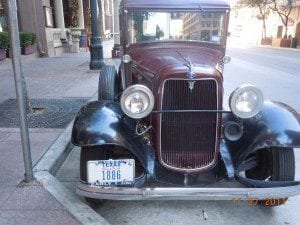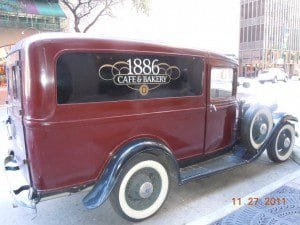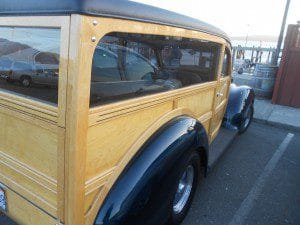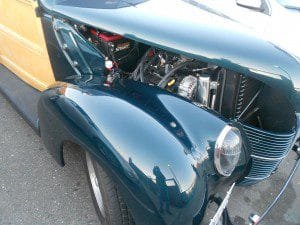The Driskill Hotel is probably the most historic hotel in Texas and for several reasons. For one, this hotel was built in 1886 and still operates today as one of the finer hotels in Austin. In fact, at one time prior to the Texas State Capitol building being built in the 1880’s, the Driskill Hotel was used at times for legislative sessions. Like many vintage cars, the hotel was expertly remodeled to reflect it’s original beauty and is a busy hotel as well as a piece of living history.

Usually parked outside the Driskill is a 1934 Ford truck shown in this article. Some of the restored old Ford trucks look great. More than anything else, this antique truck advertises the hotel’s 1886 Cafe and Bakery and stands out quite well among cars in downtown Austin.

The bakery opened in 2002. Prior to that the area was named the 1886 Lunchroom and was established by the Heritage Society in Austin.The 1886 Cafe and bakery is open for breakfast, lunch and dinner and is worth the stop by.
Ford was very competitive during the 1930’s Great Depression years. They were known to offer reliable cars and trucks at affordable prices. This is one of the reasons Ford survived the depression when some other automakers ran into deep trouble. The 1934 Ford trucks like the one shown in this article was a panel design. Obviously good for a delivery service. The chassis was a Ford Model BB and the year 1934 was the last one using the 4 cylinder engine. The 1935 model year would show a lot of differences with both engine and design.
The second of our old Ford trucks, shown here, is a modified 1939 model. The year 1939 signaled some advances by the Ford Motor Company. Henry Ford who was notorious for keeping things the way they were finally assented to a new braking system. Ford trucks now had hydraulic systems for braking replacing the old mechanical brakes even though the founder didn’t trust them.

This was a victory for the progressives. Ford’s competitors were using hydraulic brake systems for years. Henry Ford really had no choice by 1939 than to use the hydraulic system.
Ford Motor advertisements of the era pushed the truck’s powerful V-8 engine and the ruggedness of it’s construction. One of it’s slogans was “the truck for the jobs of 1939“. One advertisement has an owner claiming to get “1,100 miles of Ford economy every week“. The economy angle was pushed hard with testimonials from several purported owners of how they’re saving money with the new 1939 model.

When looking for significant changes with old Ford trucks of the 1930’s, probably the most notable change was in Ford’s introduction of the V-8 engine. It’s main rival, Chevrolet, had introduced the 6 cylinder engine as a more powerful alternative to Ford’s four cylinder power plants. What Ford did was essentially go one better than Chevrolet with it’s V-8.
The dashboards in the late 1930’s Ford truck line unfortunately looked the same as in previous years. It was flat. It looked like it always looked. Ford’s competitors started to add style to the dashboards. This could easily have been another case of Henry Ford resisting change. It appears that Henry Ford, as evidenced in some of the ad slogans above, relied on pushing ruggedness in place of style and this included the dashboards.

As far as design goes in old Ford trucks of the 1930’s , the company made major changes in their 1930-1939 series of trucks. In short, the design was more sleek. The model BB chassis used on it’s trucks produced everything from pick up trucks, dump trucks, fire trucks to school buses.
As mentioned above, competition was fierce during the depression years of the 30’s. The 1929 model year saw record industry sales of more than 5 million vehicles. After the Crash of 1929, sales were cut in half even though car prices dropped in reaction to the economy. Ford Motor Company employed about 120,000 workers in 1929. By mid 1931 the company had about 37,000 employees. The following production figures will give you some idea of how the Great Depression cut into sales and when the figures started back up. You can see the double dip that occurred during the latter 1930’s after a mid 1930’s increase.
Total Ford Production / Cars and Trucks
1929 1.5 million 1931 615,000 1933 335,000 1935 820,000 1937 942,000 1939 487,000 1940 542,000 1941 691,000
See our article and photos of the Ford Model A Roadsters
(Photos from author’s private collection)